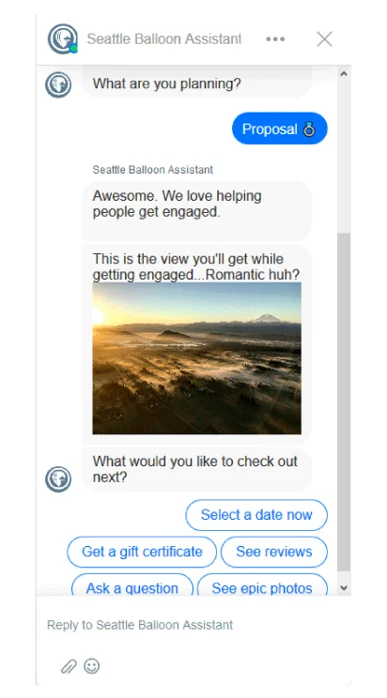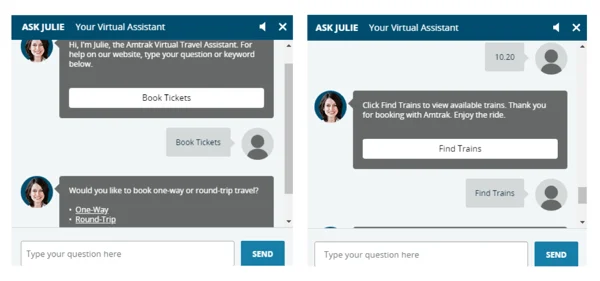B2B interaction is one business making a commercial transaction with another.
B2B chatbots can be beneficial because they can answer general FAQs, provide 24/7 customer service support, mine data and nurture leads, among other benefits.
In this article, we will explore what B2B chatbots are, how they can streamline B2B relationships, and showcase some use cases at the end.
What are B2B chatbots?
Chatbots are software applications used to conduct online conversations between users and bots, either through speech or text, instead of talking to a live agent.
In line with that, a B2B chatbot is no different than any other chatbot: Its ultimate goal is to help the counterparty get the information they need via conversing with them.
An emotional chatbot, for instance, helps the user feel heard and understood, while a B2B chatbot assists the buyer to get desired feedback from the seller.
What do B2B chatbots do?
B2B chatbots aim to connect the buyer with a product and educate them on their details.
B2B chatbots can answer FAQs, provide customer service support, nurture leads, and provide insights about the vendor to the prospective client.
What are the use cases of B2B chatbots?
The use cases of B2B chatbots are the following:
1. Lead qualification
B2B chatbots can be deployed to get potential leads engaged with the website’s content and various web pages.
A sales chatbot that can ask a website visitor the correct questions, and help them narrow down products or services that are related to their interests, will eliminate the need to sift through irrelevant content.
This is especially critical in the beginning stages of lead qualification when enabling a seamless experience for interested customers is paramount.
2. Lead nurturing
Related to the last point is lead nurturing. B2B chatbots can turn an interested lead into a paying customer by asking them relevant questions and feedback throughout their customer journey.
Asking more questions means getting more data, which in return means more tailored recommendations and knowing more about the customer’s needs.
Building relationships with prospective customers and leading them through their experience can establish loyalty and trust in the business.
3. Data mining
Sales teams need to analyze data to find out customer’s needs.
Especially in large-scale B2B marketing, it is not possible for human agents to manually mine, organize, and analyze all relevant data pertaining to services, the target audience, and other points of interest.
Bots can automate the process of data mining and can help the human staff to map the data based on the changing organizational trends. This will help sales representatives during the sales process to have access to this information immediately.
What are some case studies of B2B chatbots?
1. Zalando
The European fashion brand, Zalando, has a chatbot (see Figure 2) that can confirm orders and track shipping. Usually, to track your shipment, you have to go through your emails to find the shipping number, and then go on the shipment company’s website to track your parcel through the tracking number.
Zalando’s chatbot has a built-in feature that automatically tracks the customer’s shipment after having received their shipping ID. The benefit to this is it frees their customer support team to cater their support to customers with more nuanced problems.
2. Seattle Ballooning
Chatbots can ask sales-oriented questions and guide them to and through the checkout process. Seattle Ballooning, a company offering hot-air balloon rides, uses its chatbot (see Figure 3) to ask users relevant questions, offer alternatives, and provide personalized service throughout the purchase process. In this way, Seattle Ballooning makes its next sale with the least amount of outlay on a salesperson.
Figure 2: B2B chatbot making a sale.

Amtrak
Amtrak, the railroad service in USA and Canada, uses a chatbot (see Figure 4) that helps customers find the shortest routes to their favorite destination. The chatbot asks the customer what they want to do (e.g. book a ticket), journey type (e.g. one way or round trip), and the date of their departure.
According to one study, by quickening up and simplifying the purchasing process, Amtrak was able to increase its booking rate by 25% and saw a 50% rise in user engagement and customer service.
Figure 3: B2B chatbot simplifying a purchase.

For more on chatbots
If you are interested in learning more about chatbots, feel free to read:
- Top 14 Open Source Chatbots
- Chatbots vs. Conversational AI: Glaring Differences
- Top 10 Insurance Chatbots Applications & Use cases
Finally, If you believe your business will benefit from implementing a chatbot, feel free to check our chatbot platform, where we have data-driven lists of vendors.
And we can guide you through the process:

Comments
Your email address will not be published. All fields are required.